Physical Address
304 North Cardinal St.
Dorchester Center, MA 02124
Pericardial diseases have a varied clinical presentation, ranging from chronic or subacute to acute and potentially life threatening. These pathologies often present urgently to the operating room, and their perioperative management poses unique challenges for the anesthesiologist. The hemodynamic compromise resulting from some of these conditions (e.g., tamponade) often requires emergent management. Routine perioperative interventions, such as positive pressure ventilation, may have an adverse impact on hemodynamics. Therefore safe anesthetic care of patients with pericardial disease requires a thorough understanding of the pathophysiology and associated hemodynamic changes.
The word pericardium derives from the Greek word perikardion ( peri = around, about + kardia = heart). The pericardium is a protective fibroserous sac that envelopes the heart and portions of the great vessels. It is composed of two intimately related layers, the serosa (inner layer) and the fibrosa (outer). The serosa or serous pericardium is composed of a visceral layer of epicardium and a parietal layer; the space in between the two is the pericardial cavity. Under physiologic conditions, the pericardial cavity is filled with approximately 10 to 50 mL of pericardial fluid, a plasma ultrafiltrate. The parietal serous pericardium is adjacent to the fibrous pericardium ( Fig. 11.1 ).
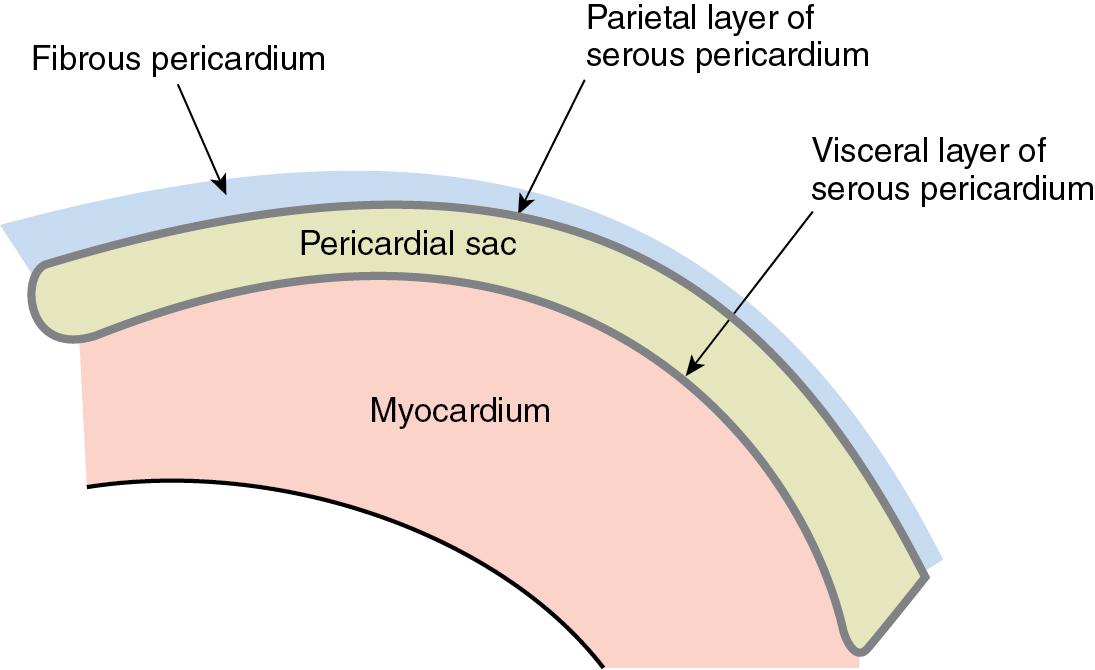
The normal pericardium is approximately 0.8 to 1 mm in thickness but may vary depending on the anatomic region. Pericardial reflections around the great vessels and pulmonary veins form a U-shaped oblique sinus behind the left atrium and between the inferior vena cava and the pulmonary veins, and a transverse sinus between the aorta and pulmonary artery and the dome of the left atrium and superior vena cava. These potential spaces may accommodate a small amount of pericardial fluid and are important to compensate for changes in intrapericardial pressure during the cardiac cycle. Lymphatic drainage of pericardial fluid occurs via the tracheal, bronchial, anterior, and posterior mediastinal lymph nodes.
Histologically, the pericardium is composed of a dense parallel array of collagen layers interspaced with short elastin fibers. This structure is responsible for the viscoelastic mechanical properties of the pericardium. Conceptually, it is useful to visualize the pericardium as having two different resistances to mechanical stress. Small effusions stretch only the elastic fibers, while the expansion produced by larger, high-pressure effusions is opposed by the resistance of the more rigid collagen fibers. This results in the characteristic steep J shape of the pericardial pressure-volume relationship curve ( Fig. 11.2 ).
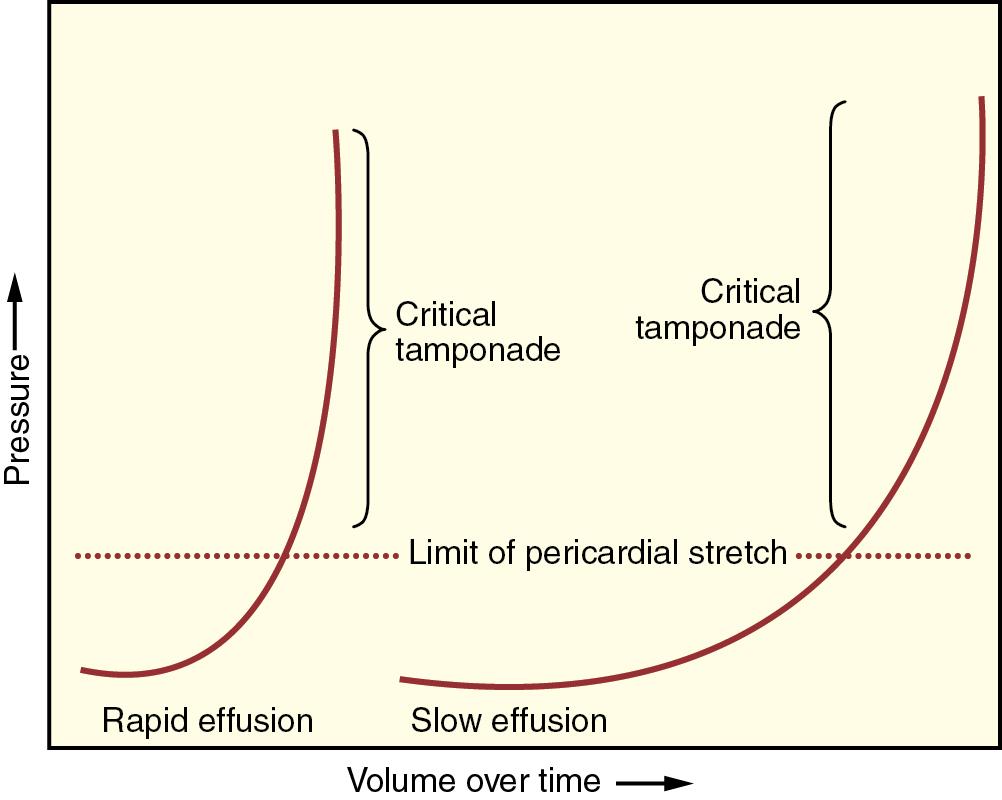
The stiffness of the pericardium is higher than that of the cardiac muscle. Therefore the pericardium allows for equalization of the compliance of both ventricles, maximizing diastolic ventricular interaction. As an example, the intrapericardial pressure follows the changes in intrathoracic pressure during respiration. The negative intrathoracic pressure during inspiration increases right ventricular filling. The interventricular septum accommodates this increase in right ventricular filling pressures by shifting leftward, therefore impairing left ventricular filling and causing a transient decrease in cardiac output and systemic blood pressure. This phenomenon is also known as ventricular interdependence. As we will discuss later, these physiologic changes are exaggerated when intrapericardial pressures are elevated and manifest clinically as pulsus paradoxus ( Fig. 11.3 ).
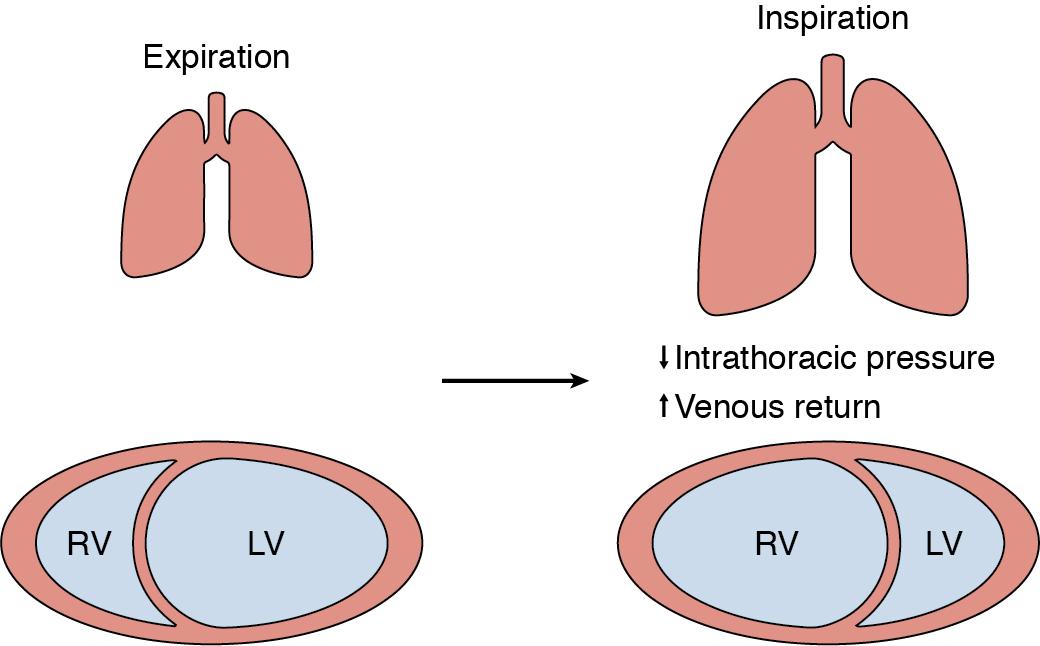
The pericardium is not essential for sustaining life, and congenital partial or complete absence of the pericardium can occur. Partial absence of pericardium is most frequently left sided. Most of these abnormalities are clinically silent, but in some cases they can result in herniation, ischemia, or strangulation of cardiac structures and sudden death.
Pericardial cysts are the most common congenital pericardial disorder ( Fig. 11.4 ). They are most commonly incidental findings on chest imaging, but occasionally may present with respiratory symptoms, dyspnea, arrhythmias, and compression of surrounding structures or may become infected. In cases that need intervention, surgical excision via video-assisted thoracoscopic surgery is preferred due to the high incidence of recurrence with percutaneous drainage (∼30%).
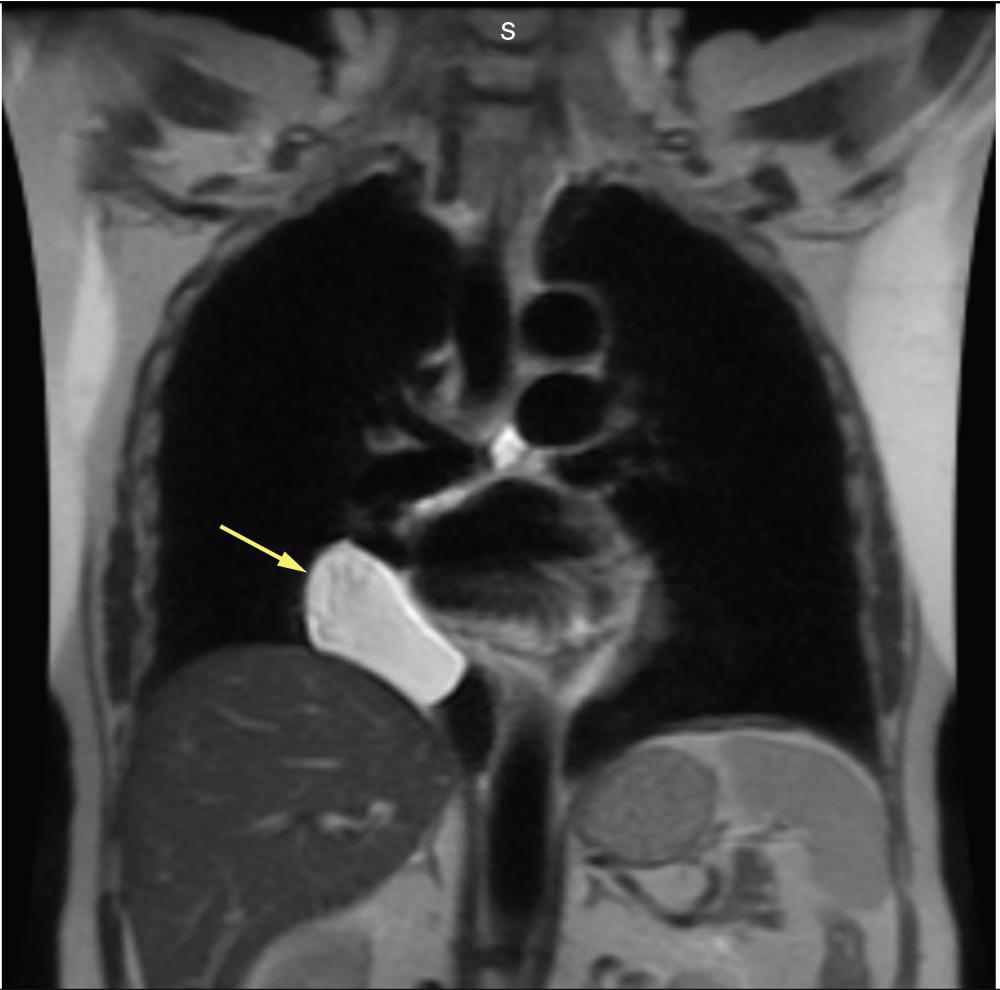
Pericarditis, the most common pericardial disorder, is an inflammatory syndrome of the pericardium that may or may not be accompanied by pericardial effusion. Pericarditis is responsible for approximately 5% of chest pain evaluations in the emergency department that are not attributed to myocardial infarction.
Pericarditis is classified based on the duration and recurrence of signs and symptoms. The symptoms of acute pericarditis usually last 2 to 4 weeks, incessant pericarditis 1 to 3 months, and chronic pericarditis more than 3 months. Recurrent pericarditis is defined as a recurrence of symptoms after a 4- to 6-week symptom-free period. Acute pericarditis has multiple etiologies, but it is often idiopathic ( Table 11.1 ).
| Idiopathic Infectious Viral: coxsackie, adenovirus, Epstein-Barr virus, cytomegalovirus, human immunodeficiency virus, hepatitis B, echovirus Bacterial: Mycobacterium tuberculosis (endemic in developing countries), Streptococcus sp., Staphylococcus sp., Mycoplasma pneumoniae, Borrelia burdogferi, Haemophilus influenzae Fungal: Histoplasma capsulatum, Coccidioides immitis |
| Neoplasic Primary tumors: mesothelioma, sarcoma Metastatic tumors: breast, lung, lymphoma, leukemia, melanoma Radiation induced |
| Postcardiac Injury Trauma Postinfarction (Dressler syndrome) Postpericardiotomy |
| Medication Induced Procainamide, hydralazine, isoniazid, cyclosporine |
| Autoimmune Churg-Strauss syndrome, Wegener granulomatosis, dermatomyositis, rheumatoid arthritis, sarcoidosis, scleroderma, ankylosing spondylitis |
| Metabolic Disorders Uremia, gout, myxedema |
Diagnosis of pericarditis requires at least two of four criteria: pleuritic chest pain, a pericardial friction rub, diffuse ST-segment elevation or PR depression on electrocardiogram (ECG) ( Fig. 11.5 ), and a new or worsening pericardial effusion. ECG changes occur due to inflammation of the superficial myocardium. The chest pain of acute pericarditis can mimic coronary artery disease. Some clinical features may help differentiate between these two etiologies, including the absence of reciprocal ST-segment depressions with pericarditis ( Table 11.2 ). The diagnosis of acute pericarditis can be further supported by elevation of inflammatory markers such as C-reactive protein or erythrocyte sedimentation rate, leukocytosis, and evidence of pericardial inflammation on computerized tomography (CT) or magnetic resonance imaging (MRI).
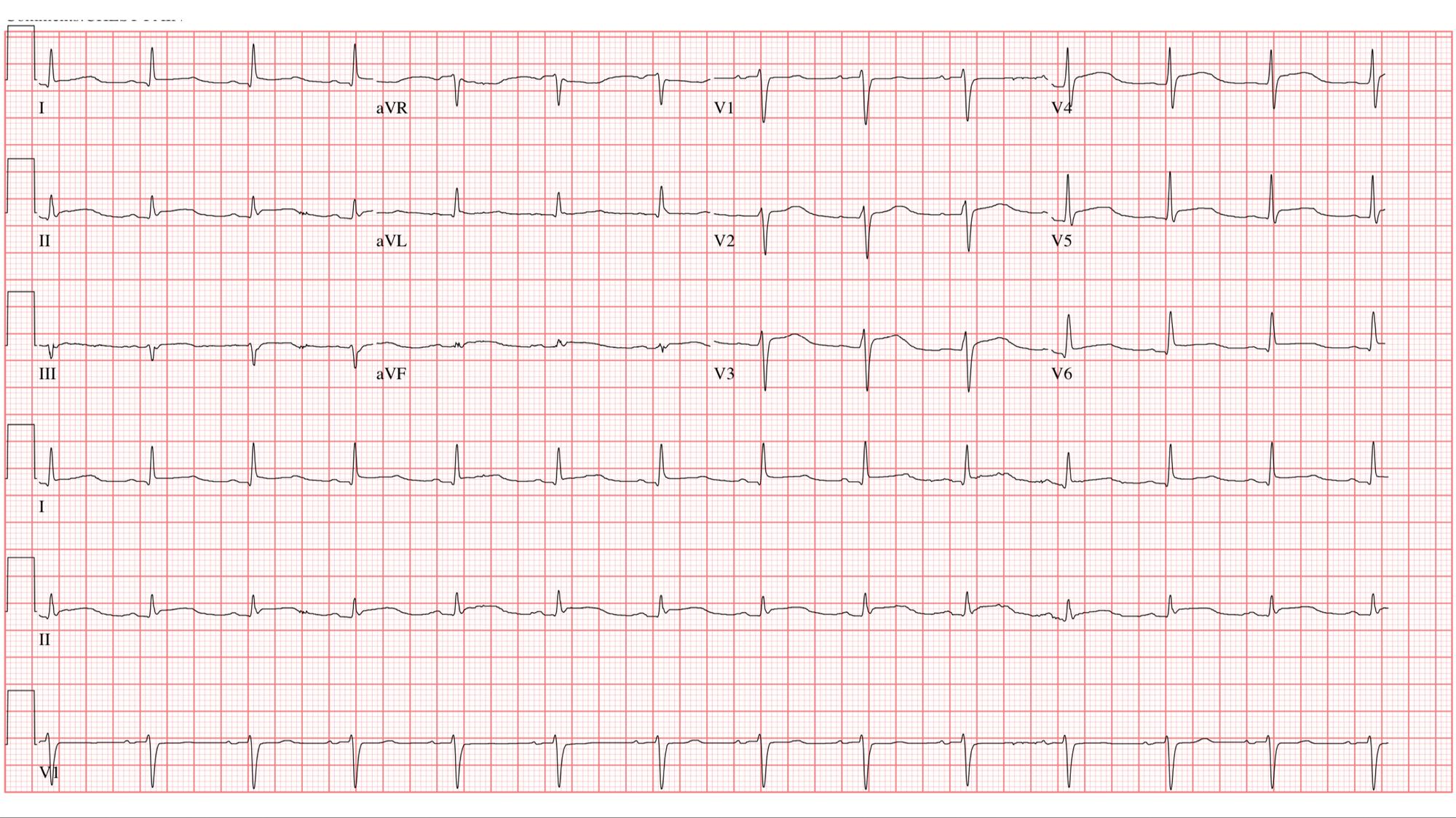
| Clinical Finding | Myocardial Ischemia | Pericarditis |
|---|---|---|
| Duration of symptoms | Minutes to hours | Hours to days |
| Pain | Retrosternal pressure, no relief with positional changes and no changes with respiration | Retrosternal, stabbing or sharp, relief with leaning forward, worsened with inspiration |
| Pain relief with nitroglycerin | Yes | No |
| Pericardial friction rub | Absent | Present |
| PR-segment depression | Absent | Present |
| ST-segment shape | Convex upward | Concave upward |
| Reciprocal ST-segment changes | Present | Absent |
Some elevation of troponin T and I can be seen as markers of myocardial injury. Troponin levels are not prognostic in these cases. Several factors are associated with increased morbidity in acute pericarditis ( Table 11.3 ).
| Fever >38°C Cardiac tamponade Large effusion size (measuring >20 mm on TTE) Subacute onset Lack of response to NSAIDs |
Pericardial inflammation results in edema, thickening of the parietal pericardium, and exudative pericardial effusion. Up to 15% of cases of acute pericarditis can be associated with myocarditis, which may result in a modest elevation of cardiac biomarkers with normal (myopericarditis) or depressed (perimyocarditis) left ventricular function.
Cardiac imaging modalities such as transthoracic echocardiography (TTE) or transesophageal echocardiography (TEE) can identify increased echogenicity of the pericardium and help evaluate complications such as effusion, constrictive pericarditis, or associated regional wall motion abnormalities. In general, larger effusions are associated with a higher risk of complications. Cardiac MRI with late gadolinium enhancement can also provide morphologic and hemodynamic information. In the absence of disease, the pericardium is not vascularized. Pericarditis causes neovascularization of the pericardium that can be detected by late gadolinium enhancement.
Treatment of the underlying etiology of pericarditis is not always possible given the large proportion of patients in which it is idiopathic. Drugs such as colchicine and nonsteroid antiinflammatories (NSAIDs) are the mainstay of treatment for pericarditis and work by reducing inflammation. Besides managing inflammation, NSAIDs also provide symptomatic relief. The use of these drugs is often limited by their contraindications and adverse effects ( Table 11.4 ). There is some evidence that colchicine alone or combined with NSAIDs may reduce the recurrence of pericarditis. Corticosteroids may also be useful in decreasing inflammation but are associated with an increased risk of relapse after discontinuation of therapy. Other drugs, such as interleukin-1 inhibitors, methotrexate, azathioprine, mycophenolate, and intravenous immunoglobulin have also been used for treatment of recurrent pericarditis. Surgical pericardiectomy is indicated in patients with refractory chest pain.
| Drug | Mechanism of Action | Dose | Treatment Course | Adverse Effects |
|---|---|---|---|---|
| Colchicine | Antiinflammatory action, interference with granulocyte function by inhibiting tubulin polymerization | 0.5mg q12 or q24 h | 3 months, taper over 2–3 weeks | Nausea and vomiting Abdominal pain Diarrhea Myopathy Neutropenia Aplastic anemia Neutropenia |
| Aspirin | Nonsteroid antiinflammatory drug, inhibits cyclooxygenase therefore decreasing production of proinflammatory mediators | 750–1000 mg q8h | Treat for 1–2 weeks, then taper over 3–4 weeks | Dyspepsia Gastrointestinal bleeding Antiplatelet effects Acute kidney injury Bronchospasm |
| Ibuprofen | Nonsteroid antiinflammatory drug, inhibits cyclooxygenase therefore decreasing production of proinflammatory mediators | 600–800 mg q8h | Treat for 1–2 weeks, then taper over 2–4 weeks | Similar to aspirin |
Due to an increased risk of sudden death and cardiac arrest, restriction of physical activity is advised in patients with pericarditis at least until inflammatory markers have returned to normal and the pain has subsided.
Postcardiac injury syndromes are a group of inflammatory pleuropericardial syndromes. Among these conditions, the ones most frequently encountered by the anesthesiologist are postinfarction pericarditis (Dressler syndrome), postpericardiotomy syndrome occurring after cardiac surgery, and traumatic pericarditis. The initial damage to pericardial tissue is believed to trigger an autoimmune response after an asymptomatic latent period. The diagnosis is suspected in patients who, after an initial injury, present with unexplained fever, pleuritic chest pain, pericardial rub, and elevated inflammatory markers.
Early pericarditis can occur after large transmural myocardial infarctions (1–3 days), although this is uncommon in the current era of percutaneous coronary interventions. Dressler syndrome is a late postinfarction pericarditis that usually occurs 1 to 8 weeks after the initial event. It is frequently accompanied by an effusion, although tamponade is rare. Since it is frequently associated with chest pain, it can mimic postinfarction angina.
Postpericardiotomy syndrome presents primarily as acute pericarditis in patients who have undergone cardiac surgery, with an incidence of 10% to 40%. It is more frequent in the pediatric population. Interestingly, it is rare in patients receiving immunosuppressant drugs after cardiac transplantation, which suggests an autoimmune mechanism. Although it is frequently benign, it is important to distinguish between postpericardiotomy syndrome and myocardial ischemia. Patients with postpericardiotomy syndrome are at an increased risk of reoperation for tamponade and have increased hospital length of stay.
Pericarditis can also occur after accidental or iatrogenic cardiac trauma, such as after percutaneous coronary interventions and electrophysiology procedures.
The treatment of postcardiac injury syndromes is similar to that of other forms of pericarditis. Empiric NSAIDs and colchicine are frequently prescribed and are notably less effective than in other forms of pericarditis. There are some data demonstrating the efficacy of colchicine in prevention of postpericardiotomy syndrome; however, a high incidence of gastrointestinal side effects may limit its utility.
Pericardial fluid can accumulate in the pericardial sac with virtually any form of pericardial disease. Pathologic processes that result in inflammation of the pericardium generally produce exudative pericardial effusions. Idiopathic effusions or those secondary to viral infection are frequently small and asymptomatic, whereas patients in which the effusion is secondary to bacterial processes or tuberculosis may appear septic and critically ill. Pericardial effusions can occur with primary malignant disease of the heart, or more commonly secondary to metastatic tumors, such as melanoma, lymphoma, breast, and lung cancer. Malignant disease is a frequent cause of tamponade in nonsurgical patients. Besides increased production and accumulation of pericardial fluid, effusions can also occur due to decreased reabsorption. This mechanism explains pericardial effusions that occur secondary to an increase in systemic venous pressure, such as in patients with congestive heart failure or pulmonary hypertension. The effusions in these cases are most frequently transudative.
As we reviewed previously, besides the normal volume of pericardial fluid (10–50 mL), the pericardial space can accommodate only a small quantity of additional fluid mainly through expansion of the pericardial sinuses (pericardial reserve volume). Because the pericardium is relatively noncompliant and fluid is noncompressible, accumulation of pericardial fluid may result in an increase in intrapericardial pressure and compression of cardiac cavities.
Cardiac tamponade occurs when circumferential or localized intrapericardial fluid collections exceed the pericardial reserve volume causing cardiac chamber collapse. It can also occur when localized effusions constrain cardiac filling sufficiently to impact hemodynamics.
Become a Clinical Tree membership for Full access and enjoy Unlimited articles
If you are a member. Log in here